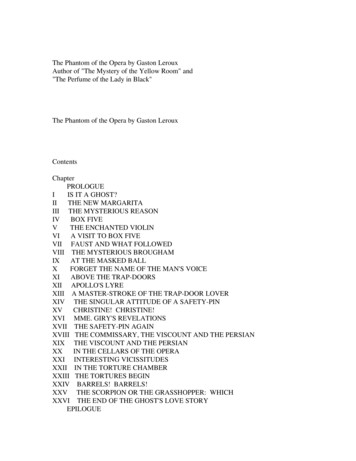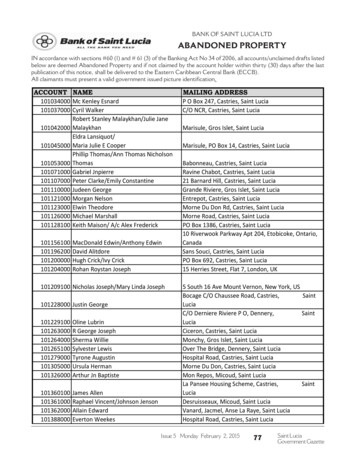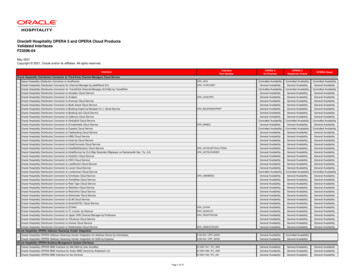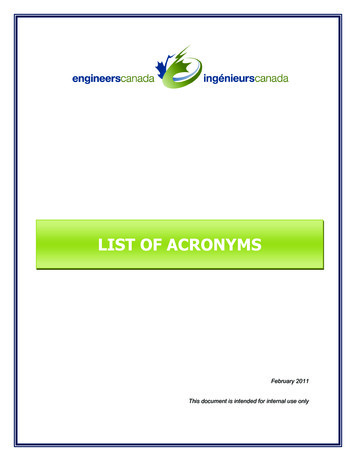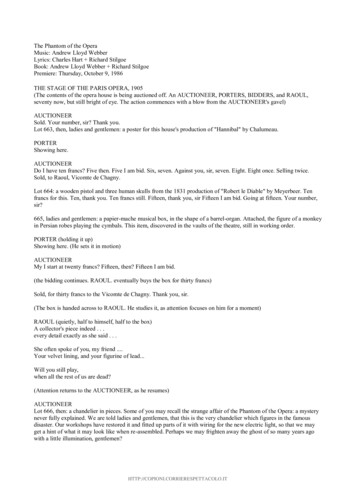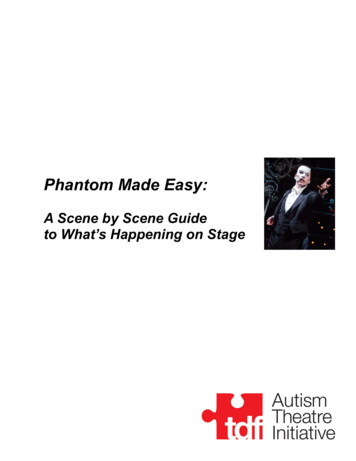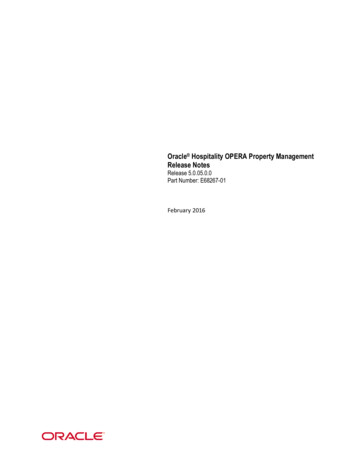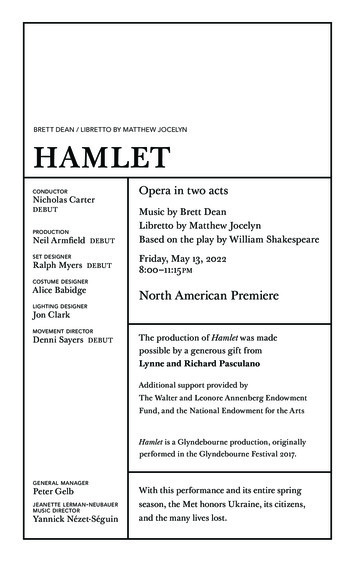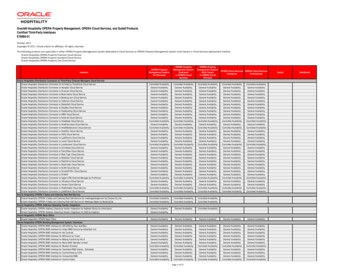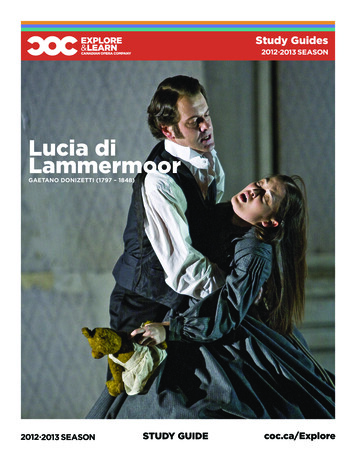
Transcription
Lucia diLammermoorGAETANO DONIZETTI (1797 – 1848)STUDY GUIDEcoc.ca/Explore
Table of ContentsWelcome. 3Opera 101. 4Attending the Opera. 5Characters and Synopsis. 7Genesis of the Opera. 8Listening Guide. 11What to Look for. 15COC Spotlight: Wayne Vogan. 17Active Learning. 18Bibliography. 18Cover: Barry Banks as Edgardo and Anna Christy as Lucia in English National Opera’s production of Lucia di Lammermoor, 2008. Photo: Clive Barda2Canadian Opera Company 2012/2013coc.caLucia di Lammermoor Study Guide
WelcomeThe Canadian Opera Company returns in 2012/2013 withthe ultimate season of drama, mischief, love, horror andsacrifice. This spring, hear Lucia hit the high notes ofmadness with Donizetti’s luscious cascading melodiesin the dark and Gothic Lucia di Lammermoor; explorethe biblical story of Salome in a celebrated productionby Canadian film director Atom Egoyan; and witness theultimate sacrifice by an order of Carmelite nuns during theFrench Revolution in director Robert Carsen’s staging ofFrancis Poulenc’s riveting Dialogues des Carmélites. Theseason is sure to inspire, shock and ignite the creativity ofyour students!New this season:Careers in Opera SpotlightThis season each Study Guide featuresa spotlight on an individual working atthe COC. Learn about the many careers inopera and discover how the COC connects toCanada’s cultural landscape.An evening at the opera is more than a night ofentertainment. Opera provides many avenues for thoughtprovoking discussions and can be explored through manysubjects beyond the arts, including history, social studies,media literacy, and yes, even science (think acousticsand sound!). The COC’s Study Guides help enhance yourstudents’ visit to the COC by giving them a glimpse intothe history, music, themes and the stories of the operas,while suggesting ways of putting their learning intopractice.Operaat any stage of life!The COC runs over 20programs for school groups, children,youth and adults. Discover more atcoc.ca/Explore!Thank you for choosing to introduce your students to thethrilling and vibrant world of opera. It takes a creativeand courageous educator to expose students to innovativesubjects beyond the traditional curriculum, and I hope thatthe COC’s Study Guides become a valuable educationalresource for your efforts.Katherine SemcesenAssociate Director, Education and OutreachCanadian Opera Company 2012/2013coc.caLucia di Lammermoor Study Guide3
Opera 101WHAT IS OPERA?The term “opera” comes from the Italian word for“work” or “piece,” and it is usually applied to theEuropean tradition of grand opera. Opera is a formof storytelling which incorporates music, dramaand design.Though its origins date back to ancient Greece,the form of opera we are familiar with todaystarted in the late 16th century in Florence,Italy. Count Giovanni de’ Bardi was a patron andhost to a group of intellectuals, poets, artists,scientists and humanists including Giulio Cacciniand Vincenzo Galilei (father to the astronomerand scientist, Galileo Galilei, who was mostfamous for his improvements to the telescope).These individuals explored trends in the arts,focusing on music and drama in particular. Theywere unified in their belief that the arts hadbecome over-embellished and that returningto the transparency of the music of the ancientGreeks, which incorporated both speech andsong, and a chorus to further the plot and providecommentary on the action, would present a morepure, natural and powerful way to tell stories andexpress emotions.The first opera, Dafne, about a nymph who fledfrom Apollo and was subsequently transformedby the gods into a laurel tree, was composed byJacopo Peri in 1597. From then on the early operasrecreated Greek tragedies with mythologicalthemes. During the 17th and 18th centuries, topicsexpanded to include stories about royalty, andeveryday or common people. Some operas were ofserious nature (called opera seria) and some lighthearted (called opera buffa). Since then operashave been written on a wide variety of topicssuch as cultural clashes (Madama Butterfly),comedic farce (The Barber of Seville), politicianson foreign visits (Nixon in China), the celebrationof Canadian heroes (Louis Riel), and children’sstories (The Little Prince), to name a few.What are the differences between operas, musicals andplays?Traditionally operas are through-sung, meaning they aresung from beginning to end with no dialogue in between.Singers must have powerful voices in order to be heard overthe orchestra (the ensemble of instrumental musicians thataccompanies the dramatic action on stage during an opera).Remember: opera singers don’t use microphones!Musicals are a combination of dialogue and sung pieces andoften include choreographed numbers. The singers oftenuse microphones and are accompanied by a pit band whichincludes more modern instruments like a drum kit, guitar andelectronic instruments.Plays are primarily spoken works of theatre with minimalsinging or music.There are always exceptions to the rule: though LesMisérables is through-sung it is still classified as a piece ofmusical theatre because of its style of music. By the sametoken, some operas, like Mozart’s The Magic Flute, havespoken dialogue in addition to singing.What does opera feel like?Take five minutes out of the school dayand instead of using regular voices to converse,ask the class to commit to singing everything. Makean agreement with the students that it’s not aboutjudging people’s voices but about freeing our naturalsounds. Make up the melodies on the spot and don’tworry about singing “correctly.” Did the musical lineshelp express or emphasize certain emotions?If so, how?The COC presents works in the western Europeantradition but musical equivalents to Europeanopera can be found in Japan, at the Peking Operain China, and in Africa where it is called EpicStorytelling.4Canadian Opera Company 2012/2013coc.caLucia di Lammermoor Study Guide
Attending the Opera:Make the most of your experienceWELCOME TO THE FOUR SEASONS CENTRE FOR THE PERFORMING ARTSPhoto: Sam JavanrouhSo you’re headed to the opera, and there are a fewquestions on your mind. What do I wear? Can I take photosof the performance? How will I understand it – isn’t operain another language?! Relax! Here are a few tips on how toget the most out of your opera experience.First, there’s the question of what to wear. Some peoplethink of the opera and imagine the entire audience deckedout in ballgowns and tuxes, but that’s just not the case!People wear all sorts of things to the opera – jeans, dresspants, cocktail dresses, suits, etc. The important thing is tobe comfortable and show personal flair. Wear somethingthat makes you feel good, whether it be jeans or yournicest tie, and grab a sweater before you leave home – theair conditioning can be a bit chilly! Additionally, skip thatspritz of perfume or cologne before you go out; theFour Seasons Centre for the Performing Arts is scent-free.Many fellow patrons are allergic to strong scents.Once you’re dressed, it’s important to arrive on time forthe show. Late patrons cannot be admitted to the theatre,and you may have to watch the first act from a screen in thelobby rather than your seat. If you need to buy or pick up aCanadian Opera Company 2012/2013ticket, arrive as early as possible, as sometimes the line-upfor the box office can be quite long before a performance!The main doors open one hour before the performancestarts. Line up there and have your ticket ready topresent to the usher. If you have any questions about theperformance, drop by the Welcome Desk to ask a memberof the COC staff, who are full of useful information notonly about the opera, but about COC programs in general.A pre-performance chat takes place in the RichardBradshaw Amphitheatre (Ring 3 of the lobby) about 45minutes before the show. These chats, given by membersof our COC Volunteer Speakers Bureau, offer valuableinsight into both the opera and the specific production thatyou’ll be seeing.Before the opera starts, take the opportunity to explorethe lobby, known as the Isadore and Rosalie Sharp CityRoom. The Four Seasons Centre is Canada’s first purposebuilt opera house, engineered with state-of-the-art designand technology for the best possible acoustics. Noticethat the sound of traffic, streetcars and the general bustleof the city barely reaches the lobby, even though an airyglass wall looks out onto one of the busiest intersections inToronto.coc.caLucia di Lammermoor Study Guide5
Stop by one of the bars and order a beverage forintermission or purchase a snack. Browse the Opera Shopto pick up a memento of your experience at the opera.(Note: the Opera Shop is not open at dress rehearsals.)Walk up the stairs, passing a sculpture as you go, and notethe floating glass staircase – the longest free-standingglass staircase in the world! On the third floor, you’ll seethe Richard Bradshaw Amphitheatre, home to our FreeConcert Series. You’ll also see a mobile by artist AlexanderCalder, adding some colour and whimsy to the space.Chimes ring throughout the lobby starting ten minutesbefore the performance, reminding everyone to get to theirseats. Head towards the door noted on your ticket, get aprogram from the usher, and find your designated seat. It’sbest to use this time to open any candies or cough dropsyou might have and turn off your cell phone – the hall isbuilt to carry sound, so small sounds travel further thanyou may think! If you’d like to get a picture of you andyour friends at the opera, do so now – photography is notpermitted once the performance begins. A camera flash isvery distracting to the performers, who are working hardto stay focused and in character.As the lights go down and the audience quiets, listencarefully. Whatever little bit of outdoor sound you mighthave heard in the lobby (a siren passing, a rumblingstreetcar) has been virtually eliminated here. Not a peep!That’s because the auditorium is physically separated fromthe outside and the ground below, making for the bestacoustic experience possible.Now it’s time to sit back and enjoy the opera! But wait –you forgot your Italian-to-English translator! Don’t worryabout it. SURTITLES are projected on a horizontal screenabove the stage. SURTITLES originate from the idea of“subtitles,” which are most commonly used in foreign filmsto make them more accessible outside of their countryof origin. The COC was the first opera company to adaptthis concept for the operatic stage. Slides containing theEnglish translation of the libretto (text for the opera) areprojected in a more visible place for the audience: abovethe stage. SURTITLES were first used by the COC at thepremiere of the opera Elektra in 1983. Only the name couldbe trademarked, as the technology for the projections wasalready in existence. Opera companies from around theworld have adopted this audience initiative under differentnames, and it has revolutionized opera stages around theworld.Make sure to show your appreciation to the performersby laughing at humorous bits or applauding after awell-performed aria. If a performer has pulled off someparticularly impressive vocal fireworks, it’s absolutelyacceptable to yell out your appreciation in addition toapplause. You may hear your fellow audience membersshouting “bravo!” for a man, “brava!” for a woman, or“bravi!” for a group of performers. Feel free to join in!Lucia di Lammermoorlasts approximately two and a halfhours, including two intermissions. Theopera will be sung in the original Italian, withEnglish SURTITLES . The Canadian OperaCompany will present Lucia di Lammermoor ina production from English National Opera,which first premiered in 2008.R. Fraser Elliott Hall.Photo: Tim Griffith6Canadian Opera Company 2012/2013coc.caLucia di Lammermoor Study Guide
Characters and SynopsisMAIN CHARACTERS (in order of vocal ardoArturoDescriptionfollower of AshtonLord Henry Ashton of LammermoorChaplain at LammermoorEnrico’s sistercompanion to LuciaMaster of RavenswoodLord Arthur BucklawVoice e Ashton family has been embroiled in an ongoing feudwith the Ravenswood family. Enrico has murdered thepatriarch of the Ravenswood clan and taken over theirlands and castle.ACT IEnrico Ashton is angry because his sister Lucia refuses tomarry Arturo Bucklaw, a powerful nobleman. The marriagewould help the Ashton family regain political strengthand dominance, but Lucia stubbornly rejects the offer. Thefamily chaplain, Raimondo, warns Enrico not to force Luciainto marriage, saying that she is still mourning her deadmother and is not ready for a romance. Normanno, Enrico’scaptain, sneers at this suggestion and tells Enrico thatLucia has in fact been leaving the castle at night to secretlymeet a man named Edgardo. Enrico is furious at this newsbecause Edgardo is his sworn enemy, a member of theRavenswood family. Enrico vows revenge.By a fountain on the castle grounds, the servant Alisabegs Lucia to forget about her reckless love affair withEdgardo but Lucia is uninterested in her companion’sadvice. Eventually Edgardo arrives saying he must set sailfor France in the morning. Before he departs, however,he intends to ask Enrico for Lucia’s hand in marriage.Knowing that her brother will refuse, Lucia convincesEdgardo to keep their love secret. He agrees and they makea vow to be faithful to each other.“Death alone can extinguish the flames of our love!”Lucia and EdgardoACT IIEnrico and Normanno have been intercepting all ofEdgardo’s letters from abroad in order to drive a wedgeCanadian Opera Company 2012/2013between the lovers. Now they have forged a letter in whichEdgardo declares that he is in love with another woman.Lucia is horrified by what she reads and plunges into totaldespair, wishing only to die. Raimondo advises Lucia tosacrifice herself for the sake of the family and go throughwith the arranged marriage to Arturo. Miserable andresigned, Lucia agrees.At the wedding ceremony, Lucia is in a daze and has tobe physically propped up by Alisa and Raimondo to signthe marriage contract. Right after she does, Edgardobursts though the doors. A violent fight nearly erupts, butRaimondo succeeds in pacifying the situation. Edgardolearns that Lucia has been married to another man andcurses her.“I love you, thankless girl, I love you still!” EdgardoACT IIIThat night, Enrico challenges Edgardo to a duel at sunrise.Meanwhile, at the castle, Raimondo interrupts the weddingcelebration, telling the guests that Lucia has stabbedArturo to death in their bedroom. Lucia appears in a stateof complete delirium, thinking she is married to Edgardo.Enrico rushes in and his fury gradually gives way to greatremorse as he witnesses Lucia’s mental unravelling.At dawn, Edgardo is awaiting the beginning of the duel.A procession of people from the castle informs him thatLucia, as she lies dying, has been calling out for him. Hesets out for the castle, but Raimondo arrives to tell him it istoo late: Lucia is dead. Overcome with the realization thatshe has loved him all along, Edgardo kills himself.“If we were kept apart on earth, may God in heaven uniteus.” Edgardococ.caLucia di Lammermoor Study Guide7
Genesis of the OperaTHE COMPOSERGaetano Donizetti (1797 – 1848) was an Italian composerwhose operas were among the greatest of the ItalianRomantic period of the 1830s and 1840s. He achievedtremendous success in his lifetime, which is not always thecase with artists! His compositional style took the Italiantradition of bel canto and gave it more dramatic urgency.Anticipating the theatrical operatic genius of GiuseppeVerdi and the verismo movement, Donizetti’s creativeoutput ranged from sparkling comedies such as L’elisird’amore (The Elixir of Love, 1832), La fille du régiment (TheDaughter of the Regiment, 1840) and Don Pasquale (1843);to serious dramas such as Lucia di Lammermoor and threeof his operas inspired by the Tudor period, Anna Bolena(Anne Boleyn, 1830), Maria Stuarda (Mary Stuart, 1835)and Roberto Devereux (1837).Verismowas a literary movementin southern Italy beginning in the1870s, characterized by gritty realism, aconcern with poverty, the use of everyday ratherthan poetic language, quotes from popular songsof the day, and a tragic ending. Verismo literatureinfluenced opera, and the first verismo work tobe adapted for the operatic stage was PietroMascagni’s Cavalleria rusticana (RusticChivalry, 1890).Bel cantoMeaning “beautiful singing” inItalian, bel canto is a term usually appliedto the period of Rossini, Bellini and Donizetti,when a highly decorated and virtuosic styleof singing was practiced.8Canadian Opera Company 2012/2013HIS INSPIRATIONThe libretto (Italian for “little book,” the term refersto the words or text of an opera) for Donizetti’s Luciadi Lammermoor was based on Sir Walter Scott’sextraordinarily popular novel The Bride of Lammermoor(1819). Europe was experiencing a romantic fascinationwith Scotland at this time, evidenced by the fact that threelibrettos based on The Bride of Lammermoor were alreadyin existence when Donizetti was composing his own takeon the story.Scott’s novel was based in part on the tragic, real life ofJanet Dalrymple. The actual story is hard to pin down,since there are at least seven versions of her short life andmarriage! But Scott pieced together enough to produce anovel that appealed greatly to readers of the time.coc.caLucia di Lammermoor Study Guide
HOW LUCIA CAME TO BEWith the success of his first Tudor-inspired opera, AnnaBolena in 1830, Donizetti achieved a high level of fameand creative control as musical director of the RoyalTheatres of Naples. Lucia di Lammermoor was the first ofthree operas he was contracted to compose for the house.He finished the composition of the music in less thansix weeks, but its performance was delayed by financialdifficulties experienced by the opera house management,resulting in the leading soprano refusing to rehearse untilshe was paid. Eventually King Ferdinand II intervened toresolve the financial problems and the opera house wasable to go ahead with the premiere.THE REACTIONLucia di Lammermoor premiered on September 26, 1835,in Naples. It was a success with both critics and audiences.The two other great Italian composers of the period,Rossini (best known for his opera, The Barber of Seville)and Bellini were no longer active, with the former retiredand the latter recently deceased. Donizetti was now theking of Italian opera and wrote of his success with Lucia:“ at the risk of sounding immodest Lucia judging bythe applause and compliments I received, pleased theaudience very much. Every number was listened to inreligious silence and then hailed with spontaneous cheers.”Lucia di Lammermoor went on to be performed all overEurope and, later, in North America. It has remained one ofthe most popular operas in the repertoire.A CHALLENGE FOR THE SINGERSLucia di Lammermoor is a superb showpiece for greatsinging and Lucia’s mad scene, in particular, providessopranos with a musical and dramatic tour de force.But the mad scene is not the finale of the opera. In fact,Donizetti noted in a letter that the creator of the role,soprano Fanny Tacchinardi-Persiani, made a terrible fussbecause after her last scene there remained another aria,sung by Edgardo, which gave the tenor final applause!Lucia is a demanding role, physically, dramatically andvocally. Great interpreters of the past include Maria Callasand Joan Sutherland. The COC is thrilled to have theAmerican soprano Anna Christy singing Lucia for us inthe spring of 2013. The production from English NationalOpera was created around her, and she has sung it to greatacclaim.Canadian Opera Company 2012/2013Anna Christy as Lucia in English National Opera’s production of Lucia diLammermoor, 2008. Photo: Clive BardaOne of themethods of extending a book’spopularity in the 19th century was to createan operatic version of it. These days, a popular bookor series is more likely to become a movie, examples beingthe Twilight and Hunger Games novels. Sir Walter Scott wasso popular in the 19th century that there were at least 50libretti based on his work, which makes Scott secondonly to William Shakespeare in the rankings ofopera-inspiring writers.coc.caLucia di Lammermoor Study Guide9
MADNESS!Even before Donizetti began work on Lucia diLammermoor, madness had become popular fodder forart of the day. It is a curious and sad fact that, at the time,certain behaviours exhibited by young women were oftenattributed to madness. Anything from wilfulness andmelancholia, to independence and sexuality might beidentified as examples of the weaker natures and minds ofwomen in the 19th century. Subsequently, lunatic asylumsduring this time were mainly populated by women.Madness was also a tantalizing condition to see embodiedon stage, as it gave audiences the thrill of witnessingmoments of extreme intimacy, vulnerability and bizarrebehaviour. Donizetti had already portrayed madness (mostnotably in his Anna Bolena), when he started work on thecomposition of Lucia.Originally Donizetti wrote the mad scene aria with a glassharmonica accompaniment, which provides a hauntingand fragile sound, emphasizing Lucia’s vulnerability.However, the glass harmonica player quit abruptly overa complaint about his pay, and a flute was substituted forthe premiere. A flute is still often used, but the CanadianOpera Company will be using the originally planned glassharmonica!Lucia diLammermoor still resonateswith audiences today. The Romeo andJuliet-style of love story and the sublimelydramatic and thrilling music are just two reasonswhy it continues to be among the mostperformed operas all over theworld.Anna Christy as Lucia in English National Opera’s production of Lucia diLammermoor, 2008. Photo: Clive BardaFor a bitof fun, check out TheGuardian’s short and irreverenttake on Lucia di Lammermoor!10Canadian Opera Company 2012/2013coc.caLucia di Lammermoor Study Guide
Listening GuideGet an earful of Donizetti’s masterpiece with our listening guide, designed to help you appreciate this bel canto gem.Recording: Gaetano Donizetti, Lucia di Lammermoor. Orchestra and Chorus of the Royal Opera House Covent Garden,under Richard Bonynge, conductor. With Joan Sutherland, Luciano Pavarotti, Sherrill Milnes, Nicolai Ghiaurov, HuguetteTourangeau. Decca, 478 1513. You can also experience the Listening Guide online at coc.ca/Radio.1MUSICAL EXCERPTAct I, cavatina/cabaletta: “Regnava nel silenzio Quando, rapito in estasi” (“Enveloped in silence Whenenraptured, ecstatic”)CONNECTION TO THE STORYLucia gazes into a fountain, recalling that here, a girl had been stabbed to death by her jealous lover andthat in these waters her body remains buried. She tells her companion, Alisa, that she has recently seenthe girl’s ghost emerge from the fountain.MUSICAL ELEMENTS AND SIGNIFICANCEThis is Lucia’s aria di sortita (entrance aria) which is written in the standard form of the period: acavatina/cabaletta in which the opening section is slower and requires the singer to vocalize on long,melodic lines in a legato (smooth) style. In the second part (the cabaletta – listen at 4:08) there is achange of focus in order to express a different emotion – in this case, joy as Lucia anticipates the arrival ofher lover, Edgardo. The cabaletta is usually faster, and requires a different type of singing – less smoothand melodic, much more florid with rapid scales (coloratura) and high notes.Despite its traditional structure, this aria is by no means a conventional expression of love, but insteadconveys a dark, foreboding mood as Lucia tells us of this violent crime of passion from the past, colouringher voice to express the shock of meeting the dead girl’s ghost at the fountain (1:16). The coloratura thathelps build the exciting conclusion of the scene is more than an opportunity to show off the singer’svirtuosity: it establishes Lucia’s delicacy and fragility from the start (4:58). We’ll hear more of this kindof music later in the opera when Lucia actually has gone mad, but here – appropriately enough for aforeshadowing scene – it is more of a taste of things to come.2MUSICAL EXCERPTAct I, duet: “Sulla tomba che rinserra il tradito genitore Ah! Verrano a te sull’aure” (“On the tomb thatholds my betrayed father’s remains Born by gentle breezes my ardent sighs will come to you”)CONNECTION TO THE STORYEdgardo explains that he once swore eternal vengeance against Lucia’s family, who had been responsiblefor his father’s death. Only love now deters him from realizing his oath. Solemnly, they exchange tokensof love before he departs.MUSICAL ELEMENTS AND SIGNIFICANCEEdgardo marks a turning point in the history of Italian tenor roles. Previously, composers wrote musicCanadian Opera Company 2012/2013coc.caLucia di Lammermoor Study Guide11
for tenors that mostly required them to sing sweetly and lyrically, not making huge demands on theirabilities to sing with too much force or drama. But throughout this opera, Donizetti gives Edgardo manyshort, dramatic phrases – emotional outbursts high in the singer’s range and sung dramatically, at fullvolume.The role does not begin with a smooth, legato vocal line as one might expect for a Romantic tenor lead,but instead, with short, jagged phrases followed by a quick rise to a demanding, dramatic high note(00:45) all of which has been carefully written to express Edgardo’s difficulties in quelling his thirst forrevenge.Eventually, this somewhat unsettled opening is transformed into what is probably the most beautiful andmemorable musical passage in the entire opera: the “Veranno a te sull’aure” (5:21) first sung by Lucia,then by Edgardo and finally by both in unison. This is the only moment in the score when happinessseems remotely possible for the ill-fated couple, as reflected by the grand, sweeping vocal line.3MUSICAL EXCERPTAct II, duet: “Appressati, Lucia Il pallor, funesto, orrendo” (“Come nearer, Lucia The pallor, so deathly,so awful”)CONNECTION TO THE STORYEnrico reproaches his sister for being unhappy on the eve of her wedding (a forced marriage to ArturoBucklaw, which Enrico hopes will repair his own family’s waning fortunes). Lucia turns on her brother forthe inhumane treatment she has received.MUSICAL ELEMENTS AND SIGNIFICANCEAlthough in bel canto operas such as Lucia di Lammermoor the focus is predominantly on the voices,Donizetti is notable for giving a greater expressive role to the orchestra. Listen at the opening for theinterrupted oboe tune that announces Lucia’s entrance into the room: its plaintive tone tells us a lot abouther mood and underscores Enrico’s smarmy, false concern for her well-being (00:46), which in seconds istransformed into a bullying rant over her love for Edgardo (beginning at 3:01).In the bel canto period, we start to see the creation of the evil “tyrant” type, usually sung by a baritone,which in turn signals the increased importance of the baritone voice: greater demands are put on thesinger to vocalize for longer periods in his upper range, with more drama, over a larger orchestra thanhad previously been required.When Enrico is given an opportunity to sing warmly in this duet, it is only with the intent to deceive:listen to the central section (7:29) where the beauty of the vocal line hides the true intent of his words,“Tradisti il tuo sangue per vil seduttore” (“You betrayed your blood to a vile seducer ”).12Canadian Opera Company 2012/2013coc.caLucia di Lammermoor Study Guide
4MUSICAL EXCERPTAct III, aria: “Spargi d’amaro pianto” (“Spread with bitter tears”)CONNECTION TO THE STORYIn the second section of Lucia’s mad scene she rushes to her brother, Enrico, believing him to be Edgardoand begs forgiveness for having married Arturo. She goes on to predict that she will soon be praying forhim in heaven.MUSICAL ELEMENTS AND SIGNIFICANCESo-called “mad scenes” like this, depicting a character’s descent into insanity, mark the culmination ofItalian Romantic opera’s main aim, which was to move the audience.The highly-decorated vocal line stands for the fantasy world into which Lucia has escaped – listen to thedazzling trills (quick oscillations between two notes) and coloratura starting at (00:59). In the contextof other 19th-century Italian operas that contain mad scenes – and they were a hugely popular trend atthe time – Lucia’s stands apart as one of the fe
Cover: Barry Banks as Edgardo and Anna Christy as Lucia in English National Opera's production of Lucia di Lammermoor, 2008. Photo: Clive Barda . the lobby, known as the Isadore and Rosalie Sharp City Room. The Four Seasons Centre is Canada's first purpose-built opera house, engineered with state-of-the-art design .
